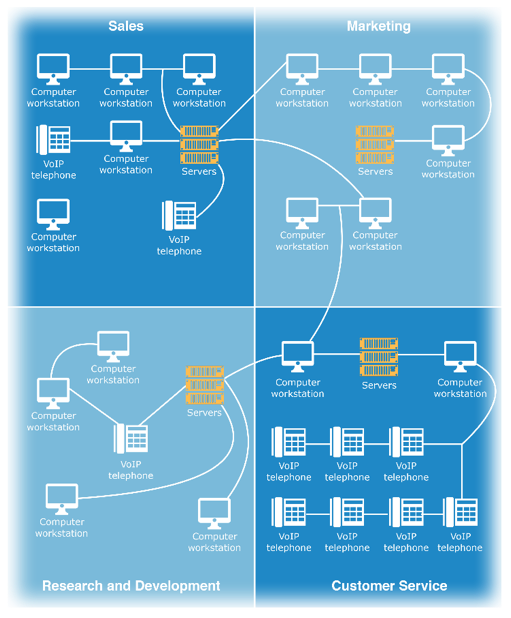Part II: Centralized vs. Decentralized IT Teams – What’s the difference?
In our last blog we reviewed the centralized structure from both an organizational and architectural set-up. With nearly 65% of businesses having made the shift, or considering making the shift, to a decentralized model- This is their story…..
Decentralized Organization
Decentralization is being tested across many enterprises. The difference in this organizational set-up assigns a tech person(s) to each LOB. This organizational shift, allows the LOB to increase their understanding of various technology challenges, but also balances those challenges/solution with a greater degree of focus on the objectives the LOB is ultimately trying to achieve. This approach also creates vastly different change to the architectural infrastructure from that found within the centralized approach – Software Advice shows the above graphical comparison.

This set-up protects an organization from enterprise wide server failure – should one server(s) go down, there’s little to no impact to the other LOBs.
Similar to the views of a centralized departmental structures, there are very strong perspectives which cannot be ignored regarding a decentralized organization, including:
- 67% agree to increased innovation
- 63% state increased employee satisfaction
- 67% believe new products roll out more quickly
Although employee satisfaction appears to be quite high, Eric Edelsberg, CultureFit Staffing Director provides a bit of caution “The decision to move to a decentralized model requires several consideration variables usually addressed at the executive level. However, there are very real impacts respective to overall performance depending on the size of the company. Typically the mid-sized companies that are able to assign 2 or more IT professionals to a line of business generate much better performance results. This eliminates any risk of isolation, facilitates collaborative problem-solving skills and the natural synergies that emerge among people working towards common goals.”
There are other reasons for decentralization which are more pragmatic from an operational perspective:
- Redundancy ranks near the top. There are few businesses that can afford to shut down operations because of a server failure. By decentralizing you’ve isolated the impact to only a fractional part of the business. But this structure is also an opportunity to build a fail-safe network to back up each department should an outage occur.
- Customized configuration by LOB. This falls into the one-size does not fit all bucket. Each LOB has the ability to select and configure the resources and applications which best fit their needs, vs. having to adjust the department’s processes to a centralized server.
- Reduced time to deploy. The decentralized structure allows each department to change, add, or remove applications, platforms, or any other new technology quickly without having to deal with a bureaucracy of decision makers. It’s invaluable time for those businesses or LOBs that operate in a regulated environment.
The decentralized model has seen the recent acceleration of adoption as cloud computing has proliferated – enabling LOBs to purchase their own cloud IT more easily. This trend is in the early stages of picking up steam, therefore it’s unlikely the decentralized organizational model will slow down anytime in the near future.
CultureFit and Advance Search bring a combination of over 10 years of IT Recruitment; entrusted to hire and place IT professionals throughout the Greater Chicagoland and Milwaukee area. Each year, they’re charged to recruit, negotiate, and place 100’s of open positions with quality talent that meet skill set requirements as well as compliment an organization’s culture. Our unique position has afforded us the opportunity to identify hiring trends from both the organization and the talent’s perspective.

